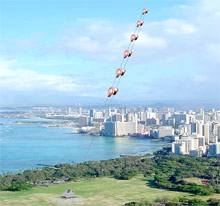A traditional childhood pastime could provide a breakthrough in renewable energy, after successful experiments in flying a giant kite at one of Europe's top research centers.
Scientists from Delft University of Technology in the Netherlands harnessed energy from the wind by flying a 10-sq meter kite tethered to a generator, producing 10 kilowatts of power.
The experiment generated enough electricity to power 10 family homes, and the researchers have plans to test a 50kW version of their invention, called Laddermill, eventually building up to a proposed version with multiple kites that they claim could generate 100 megawatts, enough for 100,000 homes.
Wubbo Ockels, a professor of sustainable engineering and former astronaut who leads the Laddermill project, believes kites are a cheap way to harvest the enormous energy in the wind at a kilometer or more above the ground, where winds carry hundreds of times more energy than on the ground. 'We need to use all the energy supplies that are offered to us by nature, we need diversity and kites are ... intriguing and fascinating,' he said.
Ken Caldeira, a climate scientist at Stanford University's Carnegie Institution, has estimated that the total energy contained in wind is 100 times the amount needed by everyone on the planet. But most of this energy is at high altitude. The blades of modern commercial windmills sit around 80 meters from the ground, where the wind speed is almost five meters per second. At 800 meters, however, wind speed rises to seven meters per second, potentially generating considerably more energy.
It would be virtually impossible to build a standard turbine to take advantage of the wind at 800 meters, but kites could easily get to these heights. Furthermore, thanks to the high-speed jet stream, countries such as the UK, the Netherlands, Ireland and Denmark are particularly suited to flying kites.
'Pretty much anywhere in the UK you could run a kite plant economically, but you couldn't run a wind turbine economically,' said Allister Furey of the University of Sussex, who develops computer control mechanisms to maximize the power generated from kites.
A kite generates power by pulling on a string attached to generators on the ground. When it has reached its maximum height, it is reeled back down to repeat the process.
Using computer models, Furey has worked out that flying kites in a figure of eight pattern means the air flowing over them travels even faster than the ambient wind speed. When a kite needs to be reeled in, it is angled so that it falls out of the sky like a glider, without the need for much power.

